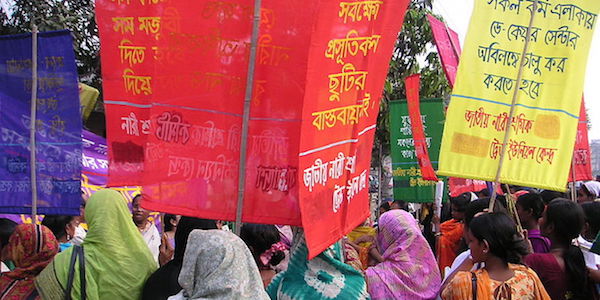 Whilst there have been some encouraging changes regarding the growing role of gender in the agendas of governments, NGOs and development agencies, development practitioner Tasmiah Rahman questions the efficacy of projects launched to address gender inequality in Bangladesh.
Whilst there have been some encouraging changes regarding the growing role of gender in the agendas of governments, NGOs and development agencies, development practitioner Tasmiah Rahman questions the efficacy of projects launched to address gender inequality in Bangladesh.
As a female development practitioner, what is encouraging to me is that gender is being discussed as a main agenda of the Sustainable Development Goal 5: Achieve gender equality and empower all women and girls. It is also encouraging to see that the Government of Bangladesh has prioritised gender issues in the 7th five-year plan (FY 2016-2020) where it mentions that women’s advancement will be ensured as self-reliant human beings.
But how effective are the numerous projects launched to address this challenge?
Now, we see Gender Mainstreaming, Gender Justice, Women’s Empowerment, Women’s Rights etc as ‘development terms’ that are used daily by development practitioners. These terms however have different meanings for different organisations and are defined within the scope of their own work.
Short-term projects can only address various parts of this large agenda and can only contribute towards the overall goal of achieving gender equality and women’s empowerment in the long run. However, these terms are often simplified. Empowerment at times end up meaning only ‘economic gain’ for project beneficiaries and not overall empowerment.
Empowerment is a strong term and should not be used lightly. It is a ‘feeling’ of capability that comes from within. It does not happen only through economic advancement but also through personal accomplishments and social acceptance. A common practice while designing projects for NGOs is adding the assumption that economic empowerment will take place if the income increases. However, are these women really empowered economically if their income increases? Is she really taking part in family decisions on savings? How many of these women hide these incomes so that their husbands don’t use it in unnecessary spending? Will we call this empowerment then?
Similarly, gender equality mainstreaming may only mean sex segregated data for projects. The number of men and women reached through an activity and not really looking at the critical qualitative aspects of their lives. Mainstreaming for many projects may only mean increasing female beneficiaries in numbers and not really looking at critical issues, such as better access to resources, rights at home or workplaces, work-life balance and last but not least, their contribution to care economy.
Thus, when projects are designed with a gender lens in mind, are we really looking at the challenges of access to services for men and women separately? Because the challenges are different. How many projects are designed in a way that look at gender mainstreaming as a process to bring about the long term ‘mindset’ change that will empower women as a solution? Or should this really be a project’s job?
Moreover, who is responsible for bringing about the structural and institutional changes that will create an environment where men and women will have equal opportunities? Projects need to critically analyse while measuring empowerment and not only report to benefit their own funding.

Women workers attend a trade union protest in Dhaka. Photo credit: Soman, CC BY 2.5.
Changing not just jobs, but also mindsets
As I work in the skills development sector, I can only share the challenges this sector is facing while mainstreaming gender. While large projects are taking shape to target poor youth to be trained for jobs which will work towards the economic growth of this country; how many of these projects are working to change the mindset of people? How many are talking to the markets so that women are not threatened in these public spaces? How many are raising awareness of the households and society so that they do not abuse the working women or see them as ‘bad influences’?
This lack of initiatives in changing mindsets mean NGOs that largely work as service delivery agents rather than advocacy and awareness building agents; often face challenges while placing these women into jobs. They also face challenges to fulfil their target of women beneficiaries while sensitising these young women. Many women and girls mention that their families will not allow them to learn different trades other than tailoring or beautician occupations as these are ‘safe’ for women.
Any woman in this country, especially in rural settings, has a lower chance of being hired at a marketplace if she is trained as an electrician. This is simply because the market is not ready to have a women electrician. The question then can arise, is a women electrician in demand? No, then why do we need to ‘push’ women to be electricians? Or may we dare ask, what if a girl wants to be an electrician? Even if she is allowed to learn the trade, she might also start working but whether she will be accepted in the market in the long run remains a question. But how many women will then be trained as tailors if new occupations do not accept women workers?
Then who is supposed to work on these ‘enabling environment’ issues where women do not feel threatened to walk to a market? Who will make the structural and institutional changes where business owners are sensitised enough to hire women in different occupations? Who will sensitise their husbands, fathers and brothers that these women should have equal access to the labour market? Lastly, who will share their care work when they are out at work?
As long as society as a whole do not feel that women need equal access to resources like men; things will move very slowly and we will have sporadic successes, not a mainstreamed one. Thus, the government can play the role of an ‘enabler’ and work with the donor community to scope sectors to assess the demand for workers and incentivise industries to hire women workers.
Government may also work with NGOs to train women in technical occupations which are in demand and then incentivise the private sector through tax cuts for hiring a certain percentage of women in their industry. Also, mass awareness campaigns are necessary to tackle the mindset change where society needs to accept women in mainstream labour market and not only precarious, low paid jobs. Only then, women’s empowerment will come out as an outcome.
This is an edited version of an article originally published by the Dhaka Tribune and has been republished with permission.
This article gives the views of the author, and not the position of the South Asia @ LSE blog, nor of the London School of Economics. Please read our comments policy before posting.
About the Author
 Tasmiah Rahman graduated from LSE with an MSc in Social Policy and Development focusing on NGO and Gender. She is a development practitioner for the last 10 years in Bangladesh and in Nepal. The contents in this article are only her opinion and not the opinion of her employer. She can be reached at t.t.rahman99@gmail.com
Tasmiah Rahman graduated from LSE with an MSc in Social Policy and Development focusing on NGO and Gender. She is a development practitioner for the last 10 years in Bangladesh and in Nepal. The contents in this article are only her opinion and not the opinion of her employer. She can be reached at t.t.rahman99@gmail.com







